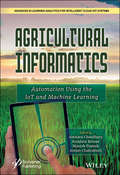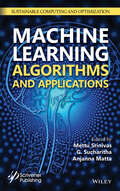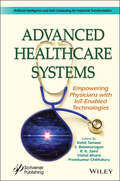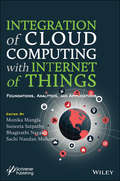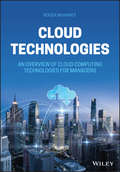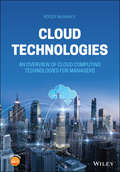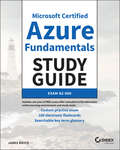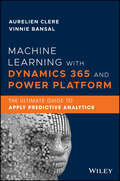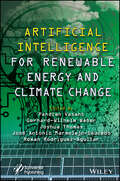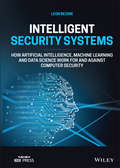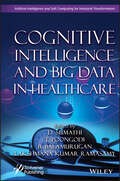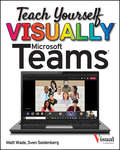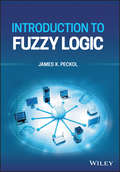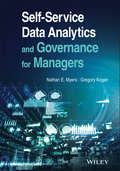- Table View
- List View
Agricultural Informatics: Automation Using the IoT and Machine Learning (Advances in Learning Analytics for Intelligent Cloud-IoT Systems)
by Amitava Choudhury Arindam Biswas Manish Prateek Amlan ChakrabartiDespite the increasing population (the Food and Agriculture Organization of the United Nations estimates 70% more food will be needed in 2050 than was produced in 2006), issues related to food production have yet to be completely addressed. In recent years, Internet of Things technology has begun to be used to address different industrial and technical challenges to meet this growing need. These Agro-IoT tools boost productivity and minimize the pitfalls of traditional farming, which is the backbone of the world’s economy. Aided by the IoT, continuous monitoring of fields provides useful and critical information to farmers, ushering in a new era in farming. The IoT can be used as a tool to combat climate change through greenhouse automation; monitor and manage water, soil and crops; increase productivity; control insecticides/pesticides; detect plant diseases; increase the rate of crop sales; cattle monitoring etc. Agricultural Informatics: Automation Using the IoT and Machine Learning focuses on all these topics, including a few case studies, and they give a clear indication as to why these techniques should now be widely adopted by the agriculture and farming industries.
Agricultural Informatics: Automation Using the IoT and Machine Learning (Advances in Learning Analytics for Intelligent Cloud-IoT Systems)
by Amitava Choudhury Arindam Biswas Manish Prateek Amlan ChakrabortyDespite the increasing population (the Food and Agriculture Organization of the United Nations estimates 70% more food will be needed in 2050 than was produced in 2006), issues related to food production have yet to be completely addressed. In recent years, Internet of Things technology has begun to be used to address different industrial and technical challenges to meet this growing need. These Agro-IoT tools boost productivity and minimize the pitfalls of traditional farming, which is the backbone of the world’s economy. Aided by the IoT, continuous monitoring of fields provides useful and critical information to farmers, ushering in a new era in farming. The IoT can be used as a tool to combat climate change through greenhouse automation; monitor and manage water, soil and crops; increase productivity; control insecticides/pesticides; detect plant diseases; increase the rate of crop sales; cattle monitoring etc. Agricultural Informatics: Automation Using the IoT and Machine Learning focuses on all these topics, including a few case studies, and they give a clear indication as to why these techniques should now be widely adopted by the agriculture and farming industries.
Machine Learning Algorithms and Applications
by Prasenjit Chatterjee Mettu Srinivas G. Sucharitha Anjanna MattaMachine Learning Algorithms is for current and ambitious machine learning specialists looking to implement solutions to real-world machine learning problems. It talks entirely about the various applications of machine and deep learning techniques, with each chapter dealing with a novel approach of machine learning architecture for a specific application, and then compares the results with previous algorithms. The book discusses many methods based in different fields, including statistics, pattern recognition, neural networks, artificial intelligence, sentiment analysis, control, and data mining, in order to present a unified treatment of machine learning problems and solutions. All learning algorithms are explained so that the user can easily move from the equations in the book to a computer program.
Machine Learning Algorithms and Applications
by Mettu Srinivas G. Sucharitha Anjanna MattaMachine Learning Algorithms is for current and ambitious machine learning specialists looking to implement solutions to real-world machine learning problems. It talks entirely about the various applications of machine and deep learning techniques, with each chapter dealing with a novel approach of machine learning architecture for a specific application, and then compares the results with previous algorithms. The book discusses many methods based in different fields, including statistics, pattern recognition, neural networks, artificial intelligence, sentiment analysis, control, and data mining, in order to present a unified treatment of machine learning problems and solutions. All learning algorithms are explained so that the user can easily move from the equations in the book to a computer program.
Advanced Healthcare Systems: Empowering Physicians with IoT-Enabled Technologies (Artificial Intelligence and Soft Computing for Industrial Transformation)
by Rohit Tanwar S. Balamurugan R. K. Saini Vishal Bharti Premkumar ChithaluruADVANCED HEALTHCARE SYSTEMS This book offers a complete package involving the incubation of machine learning, AI, and IoT in healthcare that is beneficial for researchers, healthcare professionals, scientists, and technologists. The applications and challenges of machine learning and artificial intelligence in the Internet of Things (IoT) for healthcare applications are comprehensively covered in this book. IoT generates big data of varying data quality; intelligent processing and analysis of this big data are the keys to developing smart IoT applications, thereby making space for machine learning (ML) applications. Due to its computational tools that can substitute for human intelligence in the performance of certain tasks, artificial intelligence (AI) makes it possible for machines to learn from experience, adjust to new inputs and perform human-like tasks. Since IoT platforms provide an interface to gather data from various devices, they can easily be deployed into AI/ML systems. The value of AI in this context is its ability to quickly mesh insights from data and automatically identify patterns and detect anomalies in the data that smart sensors and devices generate—information such as temperature, pressure, humidity, air quality, vibration, and sound—that can be really helpful to rapid diagnosis. Audience This book will be of interest to researchers in artificial intelligence, the Internet of Things, machine learning as well as information technologists working in the healthcare sector.
Advanced Healthcare Systems: Empowering Physicians with IoT-Enabled Technologies (Artificial Intelligence and Soft Computing for Industrial Transformation)
by Premkumar Chithaluru Rohit Tanwar S. Balamurugan Rakesh Kumar Saini Vishal BhartiADVANCED HEALTHCARE SYSTEMS This book offers a complete package involving the incubation of machine learning, AI, and IoT in healthcare that is beneficial for researchers, healthcare professionals, scientists, and technologists. The applications and challenges of machine learning and artificial intelligence in the Internet of Things (IoT) for healthcare applications are comprehensively covered in this book. IoT generates big data of varying data quality; intelligent processing and analysis of this big data are the keys to developing smart IoT applications, thereby making space for machine learning (ML) applications. Due to its computational tools that can substitute for human intelligence in the performance of certain tasks, artificial intelligence (AI) makes it possible for machines to learn from experience, adjust to new inputs and perform human-like tasks. Since IoT platforms provide an interface to gather data from various devices, they can easily be deployed into AI/ML systems. The value of AI in this context is its ability to quickly mesh insights from data and automatically identify patterns and detect anomalies in the data that smart sensors and devices generate—information such as temperature, pressure, humidity, air quality, vibration, and sound—that can be really helpful to rapid diagnosis. Audience This book will be of interest to researchers in artificial intelligence, the Internet of Things, machine learning as well as information technologists working in the healthcare sector.
Integration of Cloud Computing with Internet of Things: Foundations, Analytics and Applications (Advances in Learning Analytics for Intelligent Cloud-IoT Systems)
by Monika Mangla Suneeta Satpathy Bhagirathi Nayak Sachi Nandan MohantyThe book aims to integrate the aspects of IoT, Cloud computing and data analytics from diversified perspectives. The book also plans to discuss the recent research trends and advanced topics in the field which will be of interest to academicians and researchers working in this area. Thus, the book intends to help its readers to understand and explore the spectrum of applications of IoT, cloud computing and data analytics. Here, it is also worth mentioning that the book is believed to draw attention on the applications of said technology in various disciplines in order to obtain enhanced understanding of the readers. Also, this book focuses on the researches and challenges in the domain of IoT, Cloud computing and Data analytics from perspectives of various stakeholders.
Integration of Cloud Computing with Internet of Things: Foundations, Analytics and Applications (Advances in Learning Analytics for Intelligent Cloud-IoT Systems)
by Monika Mangla Suneeta Satpathy Bhagirathi Nayak Sachi Nandan MohantyThe book aims to integrate the aspects of IoT, Cloud computing and data analytics from diversified perspectives. The book also plans to discuss the recent research trends and advanced topics in the field which will be of interest to academicians and researchers working in this area. Thus, the book intends to help its readers to understand and explore the spectrum of applications of IoT, cloud computing and data analytics. Here, it is also worth mentioning that the book is believed to draw attention on the applications of said technology in various disciplines in order to obtain enhanced understanding of the readers. Also, this book focuses on the researches and challenges in the domain of IoT, Cloud computing and Data analytics from perspectives of various stakeholders.
Cloud Technologies: An Overview of Cloud Computing Technologies for Managers
by Roger McHaneyContains a variety of cloud computing technologies and explores how the cloud can enhance business operations Cloud Technologies offers an accessible guide to cloud-based systems and clearly explains how these technologies have changed the way organizations approach and implement their computing infrastructure. The author—a noted expert on the topic—includes an overview of cloud computing and addresses business-related considerations such as service level agreements, elasticity, security, audits, and practical implementation issues. In addition, the book covers important topics such as automation, infrastructure as code, DevOps, orchestration, and edge computing. Cloud computing fundamentally changes the way organizations think about and implement IT infrastructure. Any manager without a firm grasp of basic cloud concepts is at a huge disadvantage in the modern world. Written for all levels of managers working in IT and other areas, the book explores cost savings and enhanced capabilities, as well as identifies different models for implementing cloud technologies and tackling cloud business concerns. This important book: Demonstrates a variety of cloud computing technologies and ways the cloud can enhance business operations Addresses data security concerns in cloud computing relevant to corporate data owners Shows ways the cloud can save money for a business Offers a companion website hosting PowerPoint slides Written for managers in the fields of business, IT and cloud computing, Cloud Technologies describes cloud computing concepts and related strategies and operations in accessible language.
Cloud Technologies: An Overview of Cloud Computing Technologies for Managers
by Roger McHaneyContains a variety of cloud computing technologies and explores how the cloud can enhance business operations Cloud Technologies offers an accessible guide to cloud-based systems and clearly explains how these technologies have changed the way organizations approach and implement their computing infrastructure. The author—a noted expert on the topic—includes an overview of cloud computing and addresses business-related considerations such as service level agreements, elasticity, security, audits, and practical implementation issues. In addition, the book covers important topics such as automation, infrastructure as code, DevOps, orchestration, and edge computing. Cloud computing fundamentally changes the way organizations think about and implement IT infrastructure. Any manager without a firm grasp of basic cloud concepts is at a huge disadvantage in the modern world. Written for all levels of managers working in IT and other areas, the book explores cost savings and enhanced capabilities, as well as identifies different models for implementing cloud technologies and tackling cloud business concerns. This important book: Demonstrates a variety of cloud computing technologies and ways the cloud can enhance business operations Addresses data security concerns in cloud computing relevant to corporate data owners Shows ways the cloud can save money for a business Offers a companion website hosting PowerPoint slides Written for managers in the fields of business, IT and cloud computing, Cloud Technologies describes cloud computing concepts and related strategies and operations in accessible language.
Microsoft Certified Azure Fundamentals Study Guide: Exam AZ-900
by James BoyceQuickly preps technical and non-technical readers to pass the Microsoft AZ-900 certification exam Microsoft Certified Azure Fundamentals Study Guide: Exam AZ-900 is your complete resource for preparing for the AZ-900 exam. Microsoft Azure is a major component of Microsoft’s cloud computing model, enabling organizations to host their applications and related services in Microsoft’s data centers, eliminating the need for those organizations to purchase and manage their own computer hardware. In addition, serverless computing enables organizations to quickly and easily deploy data services without the need for servers, operating systems, and supporting systems. This book is targeted at anyone who is seeking AZ-900 certification or simply wants to understand the fundamentals of Microsoft Azure. Whatever your role in business or education, you will benefit from an understanding of Microsoft Azure fundamentals. Readers will also get one year of FREE access to Sybex’s superior online interactive learning environment and test bank, including hundreds of questions, a practice exam, electronic flashcards, and a glossary of key terms. This book will help you master the following topics covered in the AZ-900 certification exam: Cloud concepts Cloud types (Public, Private, Hybrid) Azure service types (IaaS, SaaS, PaaS) Core Azure services Security, compliance, privacy, and trust Azure pricing levels Legacy and modern lifecycles Growth in the cloud market continues to be very strong, and Microsoft is poised to see rapid and sustained growth in its cloud share. Written by a long-time Microsoft insider who helps customers move their workloads to and manage them in Azure on a daily basis, this book will help you break into the growing Azure space to take advantage of cloud technologies.
Machine Learning with Dynamics 365 and Power Platform: The Ultimate Guide to Apply Predictive Analytics
by Aurelien Clere Vinnie BansalApply cutting-edge AI techniques to your Dynamics 365 environment to create new solutions to old business problems In Machine Learning with Dynamics 365 and Power Platform: The Ultimate Guide to Apply Predictive Analytics, an accomplished team of digital and data analytics experts delivers a practical and comprehensive discussion of how to integrate AI Builder with Dataverse and Dynamics 365 to create real-world business solutions. It also walks you through how to build powerful machine learning models using Azure Data Lake, Databricks, Azure Synapse Analytics. The book is filled with clear explanations, visualizations, and working examples that get you up and running in your development of supervised, unsupervised, and reinforcement learning techniques using Microsoft machine learning tools and technologies. These strategies will transform your business verticals, reducing costs and manual processes in finance and operations, retail, telecommunications, and manufacturing industries. The authors demonstrate: What machine learning is all about and how it can be applied to your organization’s Dynamics 365 and Power Platform Projects The creation and management of environments for development, testing, and production of a machine learning project How adopting machine learning techniques will redefine the future of your ERP/CRM system Perfect for Technical Consultants, software developers, and solution architects, Machine Learning with Dynamics 365 and Power Platform is also an indispensable guide for Chief Technology Officers seeking an intuitive resource for how to implement machine learning in modern business applications to solve real-world problems.
Machine Learning with Dynamics 365 and Power Platform: The Ultimate Guide to Apply Predictive Analytics
by Aurelien Clere Vinnie BansalApply cutting-edge AI techniques to your Dynamics 365 environment to create new solutions to old business problems In Machine Learning with Dynamics 365 and Power Platform: The Ultimate Guide to Apply Predictive Analytics, an accomplished team of digital and data analytics experts delivers a practical and comprehensive discussion of how to integrate AI Builder with Dataverse and Dynamics 365 to create real-world business solutions. It also walks you through how to build powerful machine learning models using Azure Data Lake, Databricks, Azure Synapse Analytics. The book is filled with clear explanations, visualizations, and working examples that get you up and running in your development of supervised, unsupervised, and reinforcement learning techniques using Microsoft machine learning tools and technologies. These strategies will transform your business verticals, reducing costs and manual processes in finance and operations, retail, telecommunications, and manufacturing industries. The authors demonstrate: What machine learning is all about and how it can be applied to your organization’s Dynamics 365 and Power Platform Projects The creation and management of environments for development, testing, and production of a machine learning project How adopting machine learning techniques will redefine the future of your ERP/CRM system Perfect for Technical Consultants, software developers, and solution architects, Machine Learning with Dynamics 365 and Power Platform is also an indispensable guide for Chief Technology Officers seeking an intuitive resource for how to implement machine learning in modern business applications to solve real-world problems.
Artificial Intelligence for Renewable Energy and Climate Change
by Pandian Vasant Gerhard-Wilhelm Weber Joshua Thomas José Antonio Marmolejo-Saucedo Roman Rodriguez-AguilarARTIFICIAL INTELLIGENCE FOR RENEWABLE ENERGY AND CLIMATE CHANGE Written and edited by a global team of experts in the field, this groundbreaking new volume presents the concepts and fundamentals of using artificial intelligence in renewable energy and climate change, while also covering the practical applications that can be utilized across multiple disciplines and industries, for the engineer, the student, and other professionals and scientists. Renewable energy and climate change are two of the most important and difficult issues facing the world today. The state of the art in these areas is changing rapidly, with new techniques and theories coming online seemingly every day. It is important for scientists, engineers, and other professionals working in these areas to stay abreast of developments, advances, and practical applications, and this volume is an outstanding reference and tool for this purpose. The paradigm in renewable energy and climate change shifts constantly. In today’s international and competitive environment, lean and green practices are important determinants to increase performance. Corresponding production philosophies and techniques help companies diminish lead times and costs of manufacturing, improve delivery on time and quality, and at the same time become more ecological by reducing material use and waste, and by recycling and reusing. Those lean and green activities enhance productivity, lower carbon footprint and improve consumer satisfaction, which in reverse makes firms competitive and sustainable. This practical, new groundbreaking volume: Features coverage on a wide range of topics such as classical and nature-inspired optimization and optimal control, hybrid and stochastic systems Is ideally designed for engineers, scientists, industrialist, academicians, researchers, computer and information technologists, sustainable developers, managers, environmentalists, government leaders, research officers, policy makers, business leaders and students Is useful as a practical tool for practitioners in the fields of sustainable and renewable energy sustainability Includes wide coverage of how artificial intelligence can be used to impact the struggle against global warming and climate change
Artificial Intelligence for Renewable Energy and Climate Change
by Pandian Vasant Gerhard Wilhelm Weber J. Joshua Thomas José Antonio Marmolejo-Saucedo Roman Rodriguez-AguilarARTIFICIAL INTELLIGENCE FOR RENEWABLE ENERGY AND CLIMATE CHANGE Written and edited by a global team of experts in the field, this groundbreaking new volume presents the concepts and fundamentals of using artificial intelligence in renewable energy and climate change, while also covering the practical applications that can be utilized across multiple disciplines and industries, for the engineer, the student, and other professionals and scientists. Renewable energy and climate change are two of the most important and difficult issues facing the world today. The state of the art in these areas is changing rapidly, with new techniques and theories coming online seemingly every day. It is important for scientists, engineers, and other professionals working in these areas to stay abreast of developments, advances, and practical applications, and this volume is an outstanding reference and tool for this purpose. The paradigm in renewable energy and climate change shifts constantly. In today’s international and competitive environment, lean and green practices are important determinants to increase performance. Corresponding production philosophies and techniques help companies diminish lead times and costs of manufacturing, improve delivery on time and quality, and at the same time become more ecological by reducing material use and waste, and by recycling and reusing. Those lean and green activities enhance productivity, lower carbon footprint and improve consumer satisfaction, which in reverse makes firms competitive and sustainable. This practical, new groundbreaking volume: Features coverage on a wide range of topics such as classical and nature-inspired optimization and optimal control, hybrid and stochastic systems Is ideally designed for engineers, scientists, industrialist, academicians, researchers, computer and information technologists, sustainable developers, managers, environmentalists, government leaders, research officers, policy makers, business leaders and students Is useful as a practical tool for practitioners in the fields of sustainable and renewable energy sustainability Includes wide coverage of how artificial intelligence can be used to impact the struggle against global warming and climate change
Intelligent Security Systems: How Artificial Intelligence, Machine Learning and Data Science Work For and Against Computer Security
by Leon ReznikINTELLIGENT SECURITY SYSTEMS Dramatically improve your cybersecurity using AI and machine learning In Intelligent Security Systems, distinguished professor and computer scientist Dr. Leon Reznik delivers an expert synthesis of artificial intelligence, machine learning and data science techniques, applied to computer security to assist readers in hardening their computer systems against threats. Emphasizing practical and actionable strategies that can be immediately implemented by industry professionals and computer device’s owners, the author explains how to install and harden firewalls, intrusion detection systems, attack recognition tools, and malware protection systems. He also explains how to recognize and counter common hacking activities. This book bridges the gap between cybersecurity education and new data science programs, discussing how cutting-edge artificial intelligence and machine learning techniques can work for and against cybersecurity efforts. Intelligent Security Systems includes supplementary resources on an author-hosted website, such as classroom presentation slides, sample review, test and exam questions, and practice exercises to make the material contained practical and useful. The book also offers: A thorough introduction to computer security, artificial intelligence, and machine learning, including basic definitions and concepts like threats, vulnerabilities, risks, attacks, protection, and tools An exploration of firewall design and implementation, including firewall types and models, typical designs and configurations, and their limitations and problems Discussions of intrusion detection systems (IDS), including architecture topologies, components, and operational ranges, classification approaches, and machine learning techniques in IDS design A treatment of malware and vulnerabilities detection and protection, including malware classes, history, and development trends Perfect for undergraduate and graduate students in computer security, computer science and engineering, Intelligent Security Systems will also earn a place in the libraries of students and educators in information technology and data science, as well as professionals working in those fields.
Intelligent Security Systems: How Artificial Intelligence, Machine Learning and Data Science Work For and Against Computer Security
by Leon ReznikINTELLIGENT SECURITY SYSTEMS Dramatically improve your cybersecurity using AI and machine learning In Intelligent Security Systems, distinguished professor and computer scientist Dr. Leon Reznik delivers an expert synthesis of artificial intelligence, machine learning and data science techniques, applied to computer security to assist readers in hardening their computer systems against threats. Emphasizing practical and actionable strategies that can be immediately implemented by industry professionals and computer device’s owners, the author explains how to install and harden firewalls, intrusion detection systems, attack recognition tools, and malware protection systems. He also explains how to recognize and counter common hacking activities. This book bridges the gap between cybersecurity education and new data science programs, discussing how cutting-edge artificial intelligence and machine learning techniques can work for and against cybersecurity efforts. Intelligent Security Systems includes supplementary resources on an author-hosted website, such as classroom presentation slides, sample review, test and exam questions, and practice exercises to make the material contained practical and useful. The book also offers: A thorough introduction to computer security, artificial intelligence, and machine learning, including basic definitions and concepts like threats, vulnerabilities, risks, attacks, protection, and tools An exploration of firewall design and implementation, including firewall types and models, typical designs and configurations, and their limitations and problems Discussions of intrusion detection systems (IDS), including architecture topologies, components, and operational ranges, classification approaches, and machine learning techniques in IDS design A treatment of malware and vulnerabilities detection and protection, including malware classes, history, and development trends Perfect for undergraduate and graduate students in computer security, computer science and engineering, Intelligent Security Systems will also earn a place in the libraries of students and educators in information technology and data science, as well as professionals working in those fields.
Cognitive Intelligence and Big Data in Healthcare (Artificial Intelligence and Soft Computing for Industrial Transformation)
by D. Sumathi T. Poongodi S. Balamurugan R. Lakshmana KumarCOGNITIVE INTELLIGENCE AND BIG DATA IN HEALTHCARE Applications of cognitive intelligence, advanced communication, and computational methods can drive healthcare research and enhance existing traditional methods in disease detection and management and prevention. As health is the foremost factor affecting the quality of human life, it is necessary to understand how the human body is functioning by processing health data obtained from various sources more quickly. Since an enormous amount of data is generated during data processing, a cognitive computing system could be applied to respond to queries, thereby assisting in customizing intelligent recommendations. This decision-making process could be improved by the deployment of cognitive computing techniques in healthcare, allowing for cutting-edge techniques to be integrated into healthcare to provide intelligent services in various healthcare applications. This book tackles all these issues and provides insight into these diversified topics in the healthcare sector and shows the range of recent innovative research, in addition to shedding light on future directions in this area. Audience The book will be very useful to a wide range of specialists including researchers, engineers, and postgraduate students in artificial intelligence, bioinformatics, information technology, as well as those in biomedicine.
Cognitive Intelligence and Big Data in Healthcare (Artificial Intelligence and Soft Computing for Industrial Transformation)
by D. Sumathi T. Poongodi B. Balamurugan Lakshmana Kumar RamasamyCOGNITIVE INTELLIGENCE AND BIG DATA IN HEALTHCARE Applications of cognitive intelligence, advanced communication, and computational methods can drive healthcare research and enhance existing traditional methods in disease detection and management and prevention. As health is the foremost factor affecting the quality of human life, it is necessary to understand how the human body is functioning by processing health data obtained from various sources more quickly. Since an enormous amount of data is generated during data processing, a cognitive computing system could be applied to respond to queries, thereby assisting in customizing intelligent recommendations. This decision-making process could be improved by the deployment of cognitive computing techniques in healthcare, allowing for cutting-edge techniques to be integrated into healthcare to provide intelligent services in various healthcare applications. This book tackles all these issues and provides insight into these diversified topics in the healthcare sector and shows the range of recent innovative research, in addition to shedding light on future directions in this area. Audience The book will be very useful to a wide range of specialists including researchers, engineers, and postgraduate students in artificial intelligence, bioinformatics, information technology, as well as those in biomedicine.
Teach Yourself VISUALLY Microsoft Teams (Teach Yourself VISUALLY (Tech))
by Matt Wade Sven SeidenbergDiscover the power of Microsoft Teams with this intuitive and timely new guide Microsoft Teams is unlocking the potential of remote work and virtual meetings at a time when they couldn’t be more necessary. Its feature-rich interface and ease-of-use promise to bring your team together—as long as you can harness its full suite of capabilities. In Teach Yourself VISUALLY Microsoft Teams, Microsoft experts and authors Matt Wade and Sven Seidenberg turn their years of engineering and IT experience loose on the virtual collaboration software now used by over one hundred million people across the globe. Using the book’s huge collection of vibrant and full-sized images and walkthroughs, you’ll see exactly what you need to do in order to: Realize the key benefits of Teams by using its messaging and video-conferencing capabilities to stay connected with your colleagues Manage multiple teams and channels to use Teams across your organization Extend the functionality of Teams by using additional apps and add-ons Learn valuable tips, best practices, and work-arounds to make the most of and avoid the landmines in Teams Rapidly becoming the central hub for working in Microsoft 365, Microsoft Teams promises to transform the way you work and communicate. And you’ll master it faster and easier by using this ultimate guide to get the most out of Microsoft’s latest and greatest software!
Teach Yourself VISUALLY Microsoft Teams (Teach Yourself VISUALLY (Tech))
by Matt Wade Sven SeidenbergDiscover the power of Microsoft Teams with this intuitive and timely new guide Microsoft Teams is unlocking the potential of remote work and virtual meetings at a time when they couldn’t be more necessary. Its feature-rich interface and ease-of-use promise to bring your team together—as long as you can harness its full suite of capabilities. In Teach Yourself VISUALLY Microsoft Teams, Microsoft experts and authors Matt Wade and Sven Seidenberg turn their years of engineering and IT experience loose on the virtual collaboration software now used by over one hundred million people across the globe. Using the book’s huge collection of vibrant and full-sized images and walkthroughs, you’ll see exactly what you need to do in order to: Realize the key benefits of Teams by using its messaging and video-conferencing capabilities to stay connected with your colleagues Manage multiple teams and channels to use Teams across your organization Extend the functionality of Teams by using additional apps and add-ons Learn valuable tips, best practices, and work-arounds to make the most of and avoid the landmines in Teams Rapidly becoming the central hub for working in Microsoft 365, Microsoft Teams promises to transform the way you work and communicate. And you’ll master it faster and easier by using this ultimate guide to get the most out of Microsoft’s latest and greatest software!
Introduction to Fuzzy Logic
by James K. PeckolINTRODUCTION TO FUZZY LOGIC Learn more about the history, foundations, and applications of fuzzy logic in this comprehensive resource by an academic leader Introduction to Fuzzy Logic delivers a high-level but accessible introduction to the rapidly growing and evolving field of fuzzy logic and its applications. Distinguished engineer, academic, and author James K. Peckol covers a wide variety of practical topics, including the differences between crisp and fuzzy logic, the people and professionals who find fuzzy logic useful, and the advantages of using fuzzy logic. While the book assumes a solid foundation in embedded systems, including basic logic design, and C/C++ programming, it is written in a practical and easy-to-read style that engages the reader and assists in learning and retention. The author includes introductions of threshold and perceptron logic to further enhance the applicability of the material contained within. After introducing readers to the topic with a brief description of the history and development of the field, Introduction to Fuzzy Logic goes on to discuss a wide variety of foundational and advanced topics, like: A review of Boolean algebra, including logic minimization with algebraic means and Karnaugh maps A discussion of crisp sets, including classic set membership, set theory and operations, and basic classical crisp set properties A discussion of fuzzy sets, including the foundations of fuzzy set logic, set membership functions, and fuzzy set properties An analysis of fuzzy inference and approximate reasoning, along with the concepts of containment and entailment and relations between fuzzy subsets Perfect for mid-level and upper-level undergraduate and graduate students in electrical, mechanical, and computer engineering courses, Introduction to Fuzzy Logic covers topics included in many artificial intelligence, computational intelligence, and soft computing courses. Math students and professionals in a wide variety of fields will also significantly benefit from the material covered in this book.
Introduction to Fuzzy Logic
by James K. PeckolINTRODUCTION TO FUZZY LOGIC Learn more about the history, foundations, and applications of fuzzy logic in this comprehensive resource by an academic leader Introduction to Fuzzy Logic delivers a high-level but accessible introduction to the rapidly growing and evolving field of fuzzy logic and its applications. Distinguished engineer, academic, and author James K. Peckol covers a wide variety of practical topics, including the differences between crisp and fuzzy logic, the people and professionals who find fuzzy logic useful, and the advantages of using fuzzy logic. While the book assumes a solid foundation in embedded systems, including basic logic design, and C/C++ programming, it is written in a practical and easy-to-read style that engages the reader and assists in learning and retention. The author includes introductions of threshold and perceptron logic to further enhance the applicability of the material contained within. After introducing readers to the topic with a brief description of the history and development of the field, Introduction to Fuzzy Logic goes on to discuss a wide variety of foundational and advanced topics, like: A review of Boolean algebra, including logic minimization with algebraic means and Karnaugh maps A discussion of crisp sets, including classic set membership, set theory and operations, and basic classical crisp set properties A discussion of fuzzy sets, including the foundations of fuzzy set logic, set membership functions, and fuzzy set properties An analysis of fuzzy inference and approximate reasoning, along with the concepts of containment and entailment and relations between fuzzy subsets Perfect for mid-level and upper-level undergraduate and graduate students in electrical, mechanical, and computer engineering courses, Introduction to Fuzzy Logic covers topics included in many artificial intelligence, computational intelligence, and soft computing courses. Math students and professionals in a wide variety of fields will also significantly benefit from the material covered in this book.
Self-Service Data Analytics and Governance for Managers
by Nathan E. Myers Gregory KoganProject governance, investment governance, and risk governance precepts are woven together in Self-Service Data Analytics and Governance for Managers, equipping managers to structure the inevitable chaos that can result as end-users take matters into their own hands Motivated by the promise of control and efficiency benefits, the widespread adoption of data analytics tools has created a new fast-moving environment of digital transformation in the finance, accounting, and operations world, where entire functions spend their days processing in spreadsheets. With the decentralization of application development as users perform their own analysis on data sets and automate spreadsheet processing without the involvement of IT, governance must be revisited to maintain process control in the new environment. In this book, emergent technologies that have given rise to data analytics and which form the evolving backdrop for digital transformation are introduced and explained, and prominent data analytics tools and capabilities will be demonstrated based on real world scenarios. The authors will provide a much-needed process discovery methodology describing how to survey the processing landscape to identify opportunities to deploy these capabilities. Perhaps most importantly, the authors will digest the mature existing data governance, IT governance, and model governance frameworks, but demonstrate that they do not comprehensively cover the full suite of data analytics builds, leaving a considerable governance gap. This book is meant to fill the gap and provide the reader with a fit-for-purpose and actionable governance framework to protect the value created by analytics deployment at scale. Project governance, investment governance, and risk governance precepts will be woven together to equip managers to structure the inevitable chaos that can result as end-users take matters into their own hands.
Self-Service Data Analytics and Governance for Managers
by Nathan E. Myers Gregory KoganProject governance, investment governance, and risk governance precepts are woven together in Self-Service Data Analytics and Governance for Managers, equipping managers to structure the inevitable chaos that can result as end-users take matters into their own hands Motivated by the promise of control and efficiency benefits, the widespread adoption of data analytics tools has created a new fast-moving environment of digital transformation in the finance, accounting, and operations world, where entire functions spend their days processing in spreadsheets. With the decentralization of application development as users perform their own analysis on data sets and automate spreadsheet processing without the involvement of IT, governance must be revisited to maintain process control in the new environment. In this book, emergent technologies that have given rise to data analytics and which form the evolving backdrop for digital transformation are introduced and explained, and prominent data analytics tools and capabilities will be demonstrated based on real world scenarios. The authors will provide a much-needed process discovery methodology describing how to survey the processing landscape to identify opportunities to deploy these capabilities. Perhaps most importantly, the authors will digest the mature existing data governance, IT governance, and model governance frameworks, but demonstrate that they do not comprehensively cover the full suite of data analytics builds, leaving a considerable governance gap. This book is meant to fill the gap and provide the reader with a fit-for-purpose and actionable governance framework to protect the value created by analytics deployment at scale. Project governance, investment governance, and risk governance precepts will be woven together to equip managers to structure the inevitable chaos that can result as end-users take matters into their own hands.
